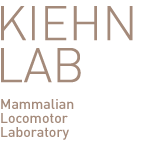


RESEARCH
Physiological and molecular organization of neuronal networks controlling locomotion in mammals
Behaviors are generated by activity in dedicated neuronal networks. It is these networks of neurons that are affected in neurological and psychiatric diseases. To comprehend the basis of behavior and cure the diseased brain a detailed understanding of the function and organization of neuronal networks in the normal brain is needed. Our lab meets this challenge by addressing the organization of neuronal networks that are linked to the ability to produce purposeful movements, in particular locomotion.
Locomotion is a complex motor act that is used in all animals and humans for interaction with the surroundings. It is used episodically in many daily life activities and is an output measure of integrated brain activity involved in exploring the environment, escaping predators, and searching for food. Its activity also directly influences the state of sensory information processing.
The planning and initiation of locomotion take place in the brain and brainstem, while the precise execution – that involves the timing and coordination – to a large part is accomplished by activity in neuronal networks in the spinal cord itself.
Early work from our lab has revealed aspects of the overall organization of the spinal locomotor network, the implication of cellular properties for rhythmicity, and the nature of neuronal spike coding. Recent work focuses on the functional organization of the networks where we have addressed organization of the key neuronal elements that that characterize limbed locomotion in mammals are: 1) the rhythm generation itself, 2) the coordination of flexors and extensors across the same or different joints in a limb or between limbs, and 3) the left/right coordination. Rhythm generating neurons set the tempo in the network and is an elementary component in all vertebrate locomotor networks. Experiments from our lab using optogenetic techniques with genetically driven expressing of light-sensitive channels in excitatory and inhibitory neurons have demonstrated that excitatory neurons in the mammalian spinal cord are both sufficient and necessary for initiating and maintaining the rhythmic locomotor pattern. Using intersectional mouse genetic in combination with electrophysiology, we have identified non-overlapping subpopulations of excitatory neurons in the spinal cord that participate in rhythm generation. We have also characterized left-right coordinating networks, which include commissural interneurons (CINs) whose axons cross the midline, in great detail by using anatomy, electrophysiology, and targeted genetic ablation of molecularly defined subpopulations of CINs. These studies have converged on a common organizational principle for circuits controlling left-right alternation in mammals including a modular organization for left-right alternating gaits (walk and trot) and synchronous gaits (gallop/bound). Moreover, we have addressed the organization of circuits involved in controlling flexor-extensor coordination. We are now addressing the functional integration of these diverse circuit elements using both in vitro and in vivo studies. In a general scheme of motor control we study how the spinal locomotor circuits are activated and controlled from descending command signals. Decision-making signal to locomote are conveyed from the brain to locomotor regions in the midbrain. The locomotor regions in the midbrain include what has been named the mesencephalic locomotor region (MLR) – a complex not well understood structure - that in turn is thought to activate neurons in the reticulospinal neuron (RF) in the lower brainstem, which project to the locomotor network in the spinal cord. In the first optogenetics experiments in the mammalian locomotor system we have provided direct evidence that glutamatergic neurons in the lower brainstem can provide a ‘go’- signal sufficient to activate the spinal locomotor networks. We now implement in vivo optogenetics and chemogenetic to probe the involvement of locomotor promoting and locomotor arresting areas in the brainstem and explore how these circuits are selected form upstream motor circuits.
Our lab has developed a broad experimental repertoire, that includes the production of transgenic mice lines tailored for the locomotor experiments, application of genetically driven tracing, in vivo and in vitro electrophysiology, imaging, optogenetics, and behavioral analyses. These tools provide a solid basis for the sophisticated functional and network studies needed to understand the principal mode of operation of a large-scale mammalian motor circuits.
Plateau potentials: a cellular mechanism underlying spasticity after spinal cord injury
Severe abnormal motor function like spasticity develops as a consequence of spinal cord injury or damage to motor pathways from the brain. We previously made the hypothesis and provided evidence that the pathophysiology of spasticity is positively related to chronic expression of plateau properties in motor neurons after spinal cord injury. Plateau potentials in vertebrate motor neurons are mediated by activation of prolonged sodium/calcium currents and the expression is conditional upon activation of noradrenergic and/or serotoninergic receptors. The normal function of motor neuron plateau potentials seems to be to maintain persistent motor output and amplify synaptic inputs during rhythmic motor activity. To find possible targets for regulation of the chronic expression of plateau potentials after spinal cord injury we have used global gene-expression analysis from isolated rat motor neurons before and after injury to the cord using Micro-array analysis. These studies have shown that the chronic expression of plateaux may be related to changes in genes coding for the regulatory units for persistent sodium and calcium channels as well as a number of intracellular pathways that may regulate plateau expression. In ongoing experiments using both the rat and the mouse spinal cord we aim at performing targeted manipulations of these pathways. Moreover we investigate the interaction of plateau potentials with changes in interneuronal network activity using mouse genetic, calcium imaging, and in vivo optogenetic. Our long-term goal is to define new therapies for symptoms associated with spinal cord injury.

